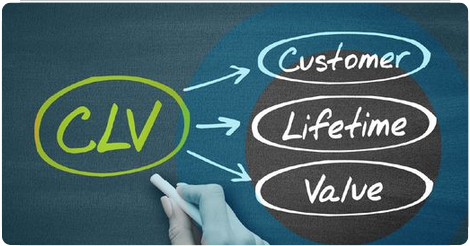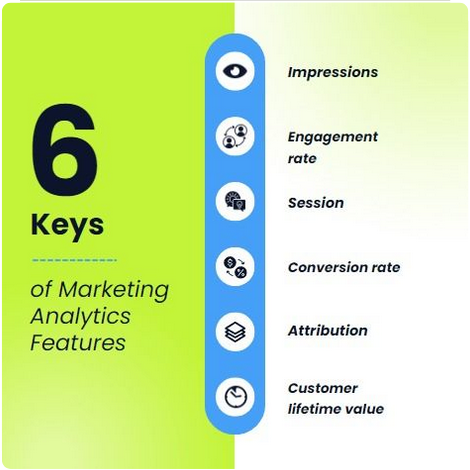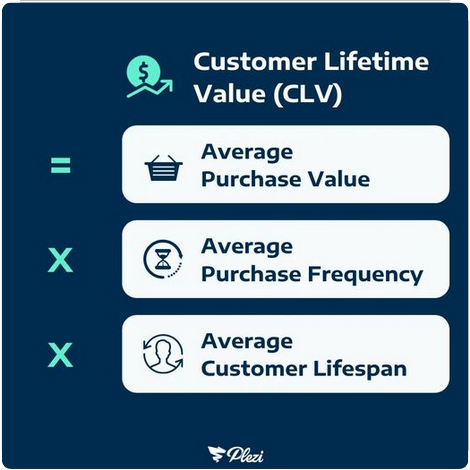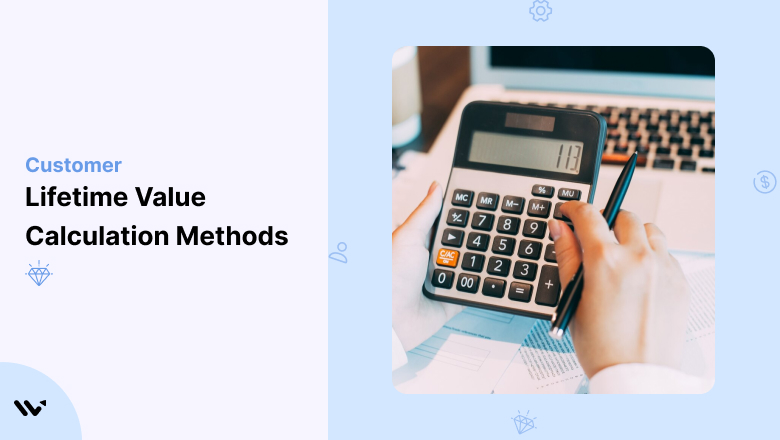With the growing competition, understanding your customers is key to success.
One crucial metric that plays a key role and provides valuable insights into customer behavior and business health is Customer lifetime value clv.
New customers are always exciting, but who contributes most to your business’s revenue growth?
The customer with a one-time purchase worth $1000 or who makes repeated purchases of $100 for several years?
We beat the second one.
Existing customers who make small yet repeated purchases for years are the ones who often bring more revenue than those who splurge on a discount once and don’t come back.
Hence, keeping your valuable customers happy is a way to long-term success.
But how do you figure out who those high-value customers are?
That’s where CLV enters. By calculating and optimizing CLV, businesses can enhance their marketing efforts, increase customer retention, and boost profitability.
Learning CLV can help you understand how you resonate with your target customers, whether your customers like your product or service, and how you can earn their loyalty.
This guide will discuss CLV, how to calculate it accurately, and why monitoring it is crucial.
PS: Here’s the calculator you can use to effortlessly determine customer lifetime value.
Visitors leave your website without taking action?
They don’t trust your site or feel urgency to act. WiserNotify builds both, turning doubt into action & visitors into customers.
What Is Customer Lifetime Value?

Customer Lifetime Value (CLV) is a metric that estimates the potential revenue a customer brings in over the entire relationship with the brand.
For instance, if a customer subscribes to one of your services for one year, the lifetime value of that customer is one year long.
Hence, it’s crucial that customers stay for a long time, and more often, customers make a purchase; the great thing is CLV.
Understanding CLV allows businesses to grasp the long-term value of their customer base.
This insight enables them to make informed decisions and strategic investments in customer service.
Why is Customer Lifetime Value Important?

CLV helps businesses understand each customer’s growth and revenue over time.
Here are some reasons why understanding CLV is important –
Revenue Prediction: CLV helps businesses predict future revenue from their existing customers, enabling them to better financial planning and resource allocation.
Customer Retention: Knowing the lifetime value of a customer helps you build strong retention strategies to reduce the strain on your team. Building strong customer relationships can improve customer retention, increasing sales and revenue.
Driving Growth: If you are focusing more on CLV and retention strategies, you might able to retain customers for a long period and drive more profitability for your business.
Improvise Products and Services: CLV can help you better understand the value customers get from your products or services. The data can be used to improve them and align with customer’s needs, and boost satisfaction.
Boost Customer Loyalty: Analyzing CLV data helps you understand customer behavior, preferences, and spending patterns when building personalized strategies and converting them into loyal customers.
Acquire More Customers: When you understand customers spend double with your business over time, you can focus on marketing strategies to reach target audiences, boost sales, and acquire new customers.
Customer Lifetime Value Formula

The customer lifetime value formula is,
CLV = Average Value Order X Purchase Frequency X Customer Lifespan.
Where,
- Average Product Value is the total revenue generated divided by the number of purchases.
- Purchase frequency is the average number of purchases per order over a specific period.
- Customer lifespan is the average duration a customer continues to buy from the business.
Let’s dive into the step-by-step process of calculating customer lifetime value.
How to Calculate Customer Lifetime Value
As a formula, it shows that the average customer lifetime value = Customer value X Average Customer Lifespan.
We can calculate customer lifetime value using two methods: Historical Data and Predictive customer lifetime value.
Here’s a step-by-step process to calculate customer lifetime value –
Step 1: Average Purchase Value –
To calculate the average purchase value, choose a specific time frame that makes sense for your business. It may be a month, a year, or more.
For example, a software company may find its sales higher in the taxation period and lower in other months by dividing the total revenue made by the total number of orders generated during the same period.
Average Purchase Value = Total Revenue/ Number of orders.
Let’s say a brand generates $20,000 in monthly revenue from an average of 100 sales. Then, the Average order value will be $200.

Pro Tip: Perform customer segmentation analysis to pinpoint your most valuable customers and tailor your strategies to enhance their experiences and maximize their lifetime value.
Step 2: Average purchase frequency rate –
Now, as we calculated the average order value, it’s time to know how often they buy. Loyal customers might make a regular purchase, but others may shop less frequently.
To calculate the average purchase frequency rate, take the total number of sales in the same period used for the average order value and divide it by the number of unique customers who made a purchase.
Average purchase frequency = Total number of purchases / Total number of unique customers.
Let’s say we stay at $20,000 in monthly sales with an average of 100 sales, and let’s say 20 customers made purchases; the average purchase frequency is 5.
Step 3: Customer Value –
The next step is to find customer value by multiplying the average order value and average purchase frequency.
This metric reveals how much revenue the average customer contributes to your business over a specified period.
Customer Value = Average order value multiplied by purchase frequency.
Keeping the above example, the customer value would be $200 X 5 = $1000.
Step 4: Average Customer Lifespan –
The average customer lifespan reflects how long customers remain engaged with your brand, from their very first purchase to their last.
It’s the duration they actively choose your business before they drift away.
You can determine your typical customer lifespan by calculating the average of these timeframes across your entire customer base.
Customer lifespan = Total customer lifespan sum/Number of customers.
If your business is new, another way to calculate customer lifespan is to divide 1 by churn rate, where churn rate measures the customers your business is losing.
Churn rate = number of customers at the start of the month – (customer at the end/customers at the start)
For this example, consider ACL = 3 years or 36 months.
Step 5: Customer lifetime value Formula –
Now, you have all the pieces of the formula. It’s time to calculate customer lifetime value.
The simplest approach is to multiply customer value by the average customer lifespan.
So, for the above example, here’s how customer lifetime value calculation can be done –
Customer Lifetime value = $ 1000 X 36 months = $36,000.
That means, on average, each customer is expected to generate $36,000 in revenue over their relationship with the business. Once you’ve
Steps to Measure Customer Lifetime Value
Measuring customer lifetime involves gathering data, customer segmentation, performing calculations, and analyzing results to understand the long-term value of your customers.
Let’s understand each point in detail.
- Collect Customer Data –
The first step is to accurately collect customer data such as customer purchases, the frequency of purchases, and customer retention rates from sources like CRM systems, sales records, and customer surveys.
- Segment Customers –
Segmenting customers means dividing your customers into groups based on similar characteristics such as purchase behavior, demographics, or engagement level.
That helps you determine which group is the most valuable.
It also helps to tailor marketing strategies and customer service efforts to each group’s needs, enhancing the business’s overall performance.
- Analyze Results –
Once you have calculated the CLV for different customer segments, it’s time for customer lifetime value analysis and understand each group’s value to your business.
Look for the patterns and trends that reveal insights into customer behavior and preferences.
For instance, one segment might have high customer lifetime value due to frequent purchases, while another might have a longer customer lifespan.
Make sure to use these insights and identify areas of improvement in customer retention, customer satisfaction, and acquisition strategies.
- Develop Strategies to Improve customer lifetime –
Based on the analysis of CLV, work with your team to develop strategies to improve customer retention, increase purchases & average revenue, enhance customer experience, and decrease customer acquisition costs.
For example, target marketing efforts could improve the purchase frequency rate if an existing customer segment shows higher CLV with increased engagement.
Focus on building long-term customer relationships and increasing lifetime value and brand loyalty.
- Monitor and Adjust –
Frequently monitor and adjust CLV to ensure the metrics stay accurate and relevant. Customer behavior and market conditions can change the impact factors of CLV.
Set up periodic review systems to re-evaluate and update the data, adjusting your marketing strategies and continuous improvement.
It allows you to remain competitive and focus on delivering customer value.
Build trust & FOMO
Highlight real-time activities like reviews, sales & sign-ups.
5 Examples of Customer Lifetime Value (CLV)
Let’s look at some examples to understand CLV in different industries –
Example 1: E-commerce Shop
Consider an eCommerce company selling luxury shoes online. Here’s some data to calculate customer lifetime value:
Average order value: $400
Purchase Frequency: 3 times per year
Customer Lifespan: 5 years
Using the CLTV formula: $400 X 3 X 5 = $6000
Therefore, the Customer lifetime value for the eCommerce company would be $6000 in this example.
That means, on average, it is expected to generate $6000 in revenue over a lifetime from a customer.
Example 2: Subscription Services
Let’s assume a software company selling productive management software has multiple pricing plans for using their platform.
The average customer spends $350 monthly, typically subscribes for 5 years, and uses automotive payment systems.
The CLV = $350 X 12 (annual purchase) X 5 = $21,000
Example 3: Car Dealership
A car dealer has total revenue of $10,000,000 and total purchases of 10,000 in the last year. The total number of customers is 800, and the average customer lifespan is 7 years.
The average order value = $10,000,000/ 1,000 = $10,000
Purchase Frequency = 1,000/800 = 1.25
The average customer lifespan for the dealership is 7 years.
So, the CLV = $10,000 X 1.25 X 7 = $87,500.
Example 4: Retail Store
Consider a retail store with a total revenue of $2,000,000 and several purchases 40,000. The total number of customers is 10,000, and the average lifespan is 5 years.
Average order value = $2,000,000/ 40,000 = $50
Average purchase frequency = 40,000/10,000 = 4
Customer Lifespan = 5 years
So, CLV = $50 X 4 X 5 = $1,000
Example 5: Fitness Centre
Let’s walk through an example of calculating customer lifetime value for a fitness center using the outlined steps.
Consider total revenue as $1,200,000 with a total number of memberships of 2,000 people. The total number of customers is 1,400, with a customer lifespan of 3 years.
Average Purchase Value: $1,200,000/2,000 = $600
Purchase Frequency = 2,000/ 1,400 = 1.42
The average customer lifespan is 3 years.
So, CLV = $600 X 1.42 X 3 = $2,556
In addition to the above examples, you can also calculate customer lifetime value by segmenting the premium and regular customers to get in-depth insights.
Conclusion
Customer lifetime value clv is a powerful metric that provides in-depth insights into the long-term value of customers.
By understanding and optimizing CLV, you can lower the customer acquisition cost, make informed decisions, and enhance customer retention, ultimately driving more profits for your business.
With so many benefits and insights to be gained with customer lifetime value models, it’s hard to believe that not every business utilizes the formula to its full potential.
Understanding the components of CLV and working to build strategies like a customer loyalty program can help increase customer lifetime, increase repeat customers, and build strong customer relationships, converting them into loyal ones.






